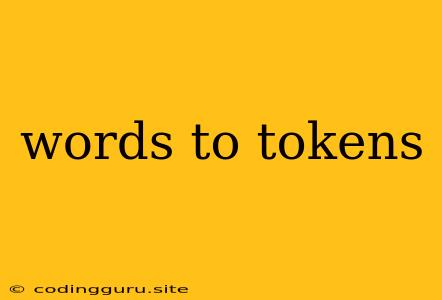Words to Tokens: Understanding the Building Blocks of Natural Language Processing
The world of natural language processing (NLP) is filled with complex algorithms and intricate models that allow computers to understand and interact with human language. At the heart of this technology lies a fundamental concept: tokenization, the process of breaking down a piece of text into its individual units, or tokens.
Why Tokenization Matters
Imagine trying to understand a sentence without knowing what individual words mean. This is essentially what a computer faces when presented with raw text. Tokenization bridges this gap, allowing machines to analyze text by dissecting it into meaningful units.
Consider these examples:
- "The quick brown fox jumps over the lazy dog." Tokenized, this sentence becomes:
['The', 'quick', 'brown', 'fox', 'jumps', 'over', 'the', 'lazy', 'dog']. - "I'm going to the store." Tokenization can also handle contractions:
['I', "'m", 'going', 'to', 'the', 'store'].
Types of Tokenization
There are several approaches to tokenization, each with its own strengths and weaknesses:
1. Word Tokenization: This is the most common type, where each word is treated as a separate token. This is effective for basic analysis, but it might not capture nuances like punctuation or special characters.
2. Character Tokenization: Here, individual characters become tokens. This is helpful for languages with complex writing systems (like Chinese or Japanese) or for tasks like spelling correction.
3. Subword Tokenization: This approach splits words into smaller units, known as subwords, based on common patterns. This is particularly valuable for handling rare or unknown words, as it allows the model to learn from smaller, more frequent units.
Tokenization in Action
Tokenization is a crucial step in many NLP tasks, including:
- Text Classification: Identifying the category of a piece of text (e.g., news, sports, entertainment).
- Sentiment Analysis: Determining the emotional tone of a text (e.g., positive, negative, neutral).
- Machine Translation: Translating text from one language to another.
- Speech Recognition: Converting spoken language into written text.
The Power of Tokenization
Tokenization serves as the foundation for many NLP applications. By breaking down text into manageable units, it unlocks the ability for computers to understand and process language with remarkable accuracy.
Understanding Tokenization: Key Points
- Tokenization is the process of breaking down text into individual units, called tokens.
- Tokenization is a fundamental step in many NLP tasks, enabling computers to understand and process human language.
- Different types of tokenization (word, character, subword) exist, each suitable for different purposes.
- Tokenization is a vital component of natural language processing, empowering machines to learn from and interact with human language.
In Conclusion, tokenization is the foundation for natural language processing. By converting words into tokens, we empower computers to understand and process language, paving the way for exciting innovations in the field of artificial intelligence.
